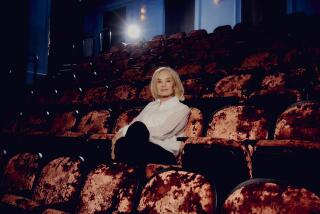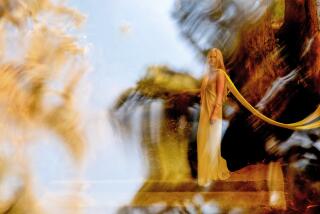STAGE REVIEW : Shock Has No Place in Hughes’ ‘World’ : Theater: Monologue by performance artist who was denied NEA grant serves as an intimate window on her childhood.
SAN DIEGO — “I can’t tell a lie any longer.”
It’s a line Holly Hughes repeats often. It’s a line she uses to anchor some of her wilder tales as if to say she is not trying to offend anyone--she is merely trying to tell the truth.
In her revealing performance-art monologue, “World Without End” Thursday at the Sushi Performance Gallery, Hughes may talk about being a lesbian, about hating men and making love with them, about the shock of seeing her mother naked and about her mother using her naked body as a way of demonstrating the facts of life.
But, despite the heightened expectation of confrontation that has come with a Hughes performance ever since the National Endowment for the Arts rescinded a grant this summer, the overwhelming feeling here is that what is said is not said to shock.
Hughes says it because it is true--and because she is sorting out where she has come from to try to understand where she is and where she is heading. Along the way, Hughes has picked up some insights that may prove useful to others, as in pointing out that to no mean extent, we are all groping our way through life by the light of what our parents taught us.
The backdrop for the show, appropriately, is a constellation chart, but the constellations are not Orion or Ursa Major. Instead they take the form of Cinderella’s slipper and a stork and a bed and a coffee pot, the shape of Hughes’ mother’s life. The light from these images underscores the warning from mother to daughter: “I don’t want you to be like me. I don’t want them to do to you what they did to me.”
What you feel here is what is conveyed by all important art--that these stories, linked together by reflections on her mother’s death, really happened, at least on an emotional level. You feel that these stories matter. Each story is a puzzle, and the puzzle must be solved to understand how all of these pieces of her life fit together.
In “World Without End,” Hughes has opened a window on an unusual life.
And oddly, too, as open as she is, Hughes leaves you wanting more, as if pieces are missing from this patchwork quilt.
What was her mother like before becoming the crazy, unhappy mother and wife (with a perpetually absent husband)? When did Hughes make her break from her mother’s way of life? Did she ever make peace with that absent father? And does she ever consider what might have been? These are some of the missing pieces of the story.
It was undoubtedly Hughes’ choice of subject matter that frightened off John E. Frohnmayer, chairman of the NEA, who personally rejected Hughes’ previously approved grant. (Frohnmayer, reportedly, has never seen the show.)
Ironically, Hughes, all dolled up in a glamorous gown with a black lace slip peeking out, doesn’t seem all that comfortable with talking about herself. She laughs to reassure after she’s said something that may sound particularly outrageous. She looks nervous from time to time. She seems vulnerable. She starts the opening scene sitting on a chair with her back to the audience, almost as if she needs a few minutes to build up her confidence before facing them.
The overall sensation she conveys is that she is having an open, intimate encounter with each individual in the space that she commands with such seeming effortlessness. She jokes at her own expense. She strides purposefully around the room, only to follow up with: “This is what they call using the space.”
She breaks the monologue to meet the eyes of people in the audience and addresses them directly.
“Are you hungry? If you are, we can stop. I know a great place . . . “ and “You mad at me? You going to leave? This is the time when most of the people leave who are going to leave” and “If you do all leave, I can go home early. . . .”
She gives one the feeling of being at the other end of a tete-a-tete, hearing the kind of things said only in the most unguarded moments. The piece, which she has done many times since she debuted it in 1989 may be scripted, but it is impeccably directed by Kate Stafford with up-to-date references on Hughes’ battle with the NEA that heighten the sense of spontaneity in her fluid, often urgent delivery.
Hughes has an expression for knowing someone else’s secret language--their language of tears and fears. It is called learning their French . She began by studying her mother’s, her own and her acquaintances’.
Hughes will continue teaching you her French through Dec. 16 at Sushi. And, if you’re a good student, she may put you in touch with your own French , a language just below the subconscious that may be more familiar than you think.
The audience at the Sushi Gallery, which can accommodate 120, numbered about 50 Thursday. Larger crowds are expected this weekend.
“WORLD WITHOUT END”
Written and performed by Holly Hughes. Director is Kate Stafford. Original music by Sharon Jane Smith with Vincent Girot and B. Bronson. Original lighting by Lori E. Seid. Gown by Susan Young. Backdrop by Donna Evans. At 8 p.m. Wednesday-Sunday through Dec. 16. Tickets are $7-$10. At 852 8th Ave., San Diego, 235-8466.
More to Read
The biggest entertainment stories
Get our big stories about Hollywood, film, television, music, arts, culture and more right in your inbox as soon as they publish.
You may occasionally receive promotional content from the Los Angeles Times.










